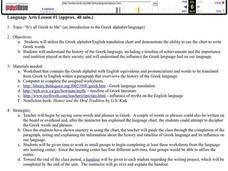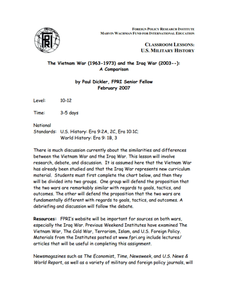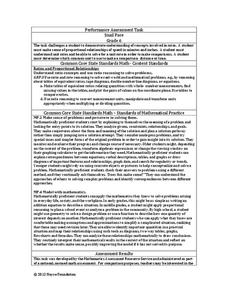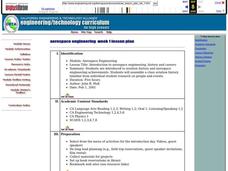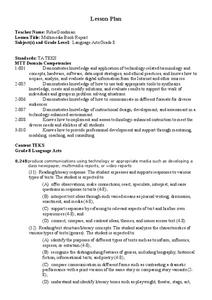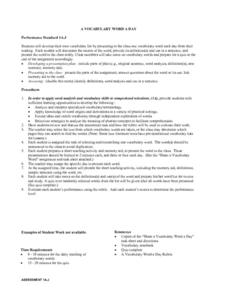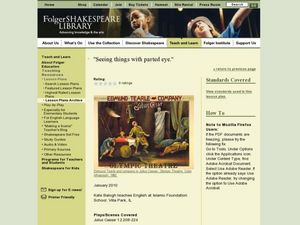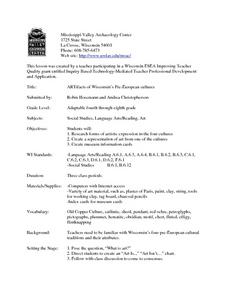Curated OER
Speak a Little Clearer!
What are the characteristics of effective public speaking? Emerging orators choose a fairy tale to present orally to the class. After modeling yourself, divide the class into small groups, having them critique each others' oral...
Curated OER
Learning from Light: The Big Bang
Learners explore what astronomers are able to examine our galaxy and universe by examining light. They explore in this sub-unit the formation of the universe, commonly called "The Big Bang," and it follows studying from the Light: The...
Curated OER
It's All Greek to Me
Introduce your class to the Greek alphabet and language. Examine how the Greek language influenced the English language. Study the history, timeline of achievements, and the role oral history played in Greece.
Foreign Policy Research Institute
The Vietnam War (1963-1973) and the Iraq War (2003---): A Comparison
If you are planning a unit on military history that includes a comparison between the Vietnam War and the Iraq War, this resource may be useful. It lists possible sources for pupils to use to complete the graphic organizer which prepares...
Noyce Foundation
Snail Pace
Slow and steady wins the race? In the assessment task, scholars calculate the rates at which different snails travel in order to find the fastest snail. Hopefully, your class will move much more quickly in finishing the task!
Curated OER
Writing: Narrative, Expository, Persuasive, and Descriptive
If you are interested in having a basic framework for teaching expository, narrative, persuasive, and descriptive writing, this resource may help; however, you will have to find information on the different forms of writing to share with...
Curated OER
Who Do You Know?
Students research and describe the contributions of African-American men and women. They write their notes in a Microsoft Word document. They present their information to the class.
Curated OER
Aerospace Engineering
Students are introduced to aviation history and aerospace engineering achievements. They assemble a class aviation history timeline from individual student research on people and events.
Curated OER
What is Culture?
Sixth graders study ancient cultures of the world. They describe the meaning of culture. Students distinguish between the material and non-material aspects of culture. They create a collage identifying the material and non-material...
Curated OER
Multimedia Book Report
Young readers plan and draft a book report focusing on the five key components of a novel: plot, character, setting, conflict, and theme. After completing a story board, pupils then prepare a PowerPoint book report that is shown to the...
Hawaiʻi State Department of Education
Beethoven’s 5th
Time to pick up an instrument and practice the first part of Beethoven's symphony No.5. Young musicians discuss melody, rhythmic pattern, dynamics, and movements found in symphonic and orchestral pieces. They then practice and play the...
Curated OER
Oral Presentation of a Research Report With Visual Support
High schoolers are introduced to the rubric to guide them in an oral presentation. Individually, they use the internet and other sources to research a predetermined topic. They must prepare and use a visual aid when presenting and answer...
Curated OER
A Vocabulary Word a Day
Students research one assigned vocabulary word and prepare a short teaching activity and memory aid to present with the word to the class. They take notes on all the new vocabulary words presented to them by other classmates then they...
Curated OER
Linear and Locomotor Movements
Students develop locomotor movements. In this dance movement instructional activity, students identify lines and develop creativity while performing to "Cha Cha Slide". Students discuss how to create dances and difficulty of movements.
Curated OER
"Seeing Things With Parted Eye."
Student read a section of Shakespeare's, Julius Caesar to identify the context. For this Shakespeare lesson, learners discuss a section of Julius Caesar to determine how Cassius feels about Antony. They work with a partner to develop a...
Curated OER
Exploring Our Cultural Heritage Through Art
Students research the art of selected cultures. In this visual arts lesson, students compose essays after they conduct independent research on the art of a culture. Students also create art proposals that feature the attributes of the...
Curated OER
Mixed Media Landscape Design
Seventh graders create mixed media representations of landscape designs in Africa and Asia. The lesson plan is great for cross-curricular projects with the Social Sciences and/or Literature, or can be used as a self-contained project. ...
Curated OER
Animals Around Us
Young scholars view and discuss a Discovery Channel video that compares the animals found in four different habitats. They compare and contrast the characteristics of forests, deserts, wetlands and grasslands then choose one to depict...
Curated OER
Comparative Genocides
Students examine genocidal events throughout history. Using the internet, they research these events and compare and contrast them with the Holocaust. They analyze the amount of inhumanity towards others throughout history. In groups,...
Curated OER
The "Art" of Baseball
Students investigate the art of baseball. In this sports lesson plan, students discuss their thoughts about the sport of baseball and create a baseball word list. Students use pattern blocks and drawing paper to create a simulated...
Curated OER
Artifacts of Wisconsin's Pre-european Cultures
Students research forms of artistic expression in four cultures. They create a representation of art from one of the cultures and create museum information cards. They develop a rubric to evaluate each others work.
Curated OER
Technology: Koo Koo for Clocks
Third graders design and make clocks compiling a materials list, creating adesign portfolio, and recording progress in a daily log. After making a full-size drawing of their clocks and with the assistance of high school technology...
Curated OER
The Real Eve
Students research about human migration during a specific time period. In this physical science lesson, students watch a video about human evolution. They prepare a presentation on human migration and share it with the class.
Cornell University
The Physics of Bridges
Stability is key when building a bridge. Scholars explore the forces acting upon bridges through an analysis of Newton's Laws and Hooke's Law. The activity asks individuals to apply their learning by building a bridge of their own.




